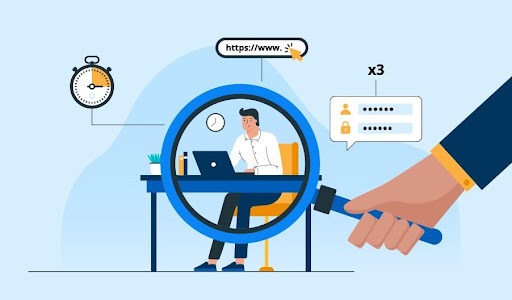Enhancing Productivity with Employee Monitoring Software for Remote Workforce Monitoring

Introduction
Digital workplaces now require business operations to depend on tools which help maintain employee productivity alongside data protection and remote team accountability metrics. The essential tool that provides valuable assistance is Employee Monitoring Software. The software assumes a vital function in workforce simplification because of increasing hybrid and remote work models.
Examining employee monitoring software defines its basic components as well as exploring its advantages and main features among other aspects that deal with ethical issues and sustaining remote workforce oversight with complete transparency.
What is Employee Monitoring Software?
Organizations use digital Employee Monitoring Software tools to track staff activities as well as productivity and behavioral patterns during their work hours. Employee monitoring systems track computer usage along with task duration and display an application recording system that generates work performance reports.
The implementation of monitoring software for employees allows enterprises to gain essential workflow performance insights for better productivity assessment. The normal business environment of remote work and digital collaboration allows monitoring software to help teams stay focused on organizational targets. The system helps discover internal security dangers while protecting business files and following industry standards.
Key Features of Employee Monitoring Software
A competent Employee Monitoring tool integrates multiple features which enable managers to track employee work patterns through ethical monitoring practices. Several key features comprise the system design:
- Time Tracking: The tool tracks time usage by recording employee work periods together with tracking inactive time and break durations for precise productivity assessments.
- Screen Monitoring: The tool performs automatic screen screenshots and records real-time screen behavior for validating correct work progress.
- Activity Logging: The system records users’ information about their internet browsing activities alongside file sharing and application usage history in order to detect unnecessary browser time and potential security threats.
- Productivity Analysis: The system produces performance metrics to allow managers to find individuals and teams who deliver maximum results.
- Automated Reports: Automatic report generation through the system provides detailed work pattern tracking data to support leadership decision-making.
The system features allow staff managers to maintain efficient team tracking without requiring constant manual involvement which benefits time distance and distributed workflows.
Benefits of Employee Monitoring Software
Employee Monitoring Software implementation produces numerous advantages for employers and their workforce.
For Employers:
- Boosted Productivity: The ability to observe work habits through monitoring leads employers to allocate tasks better which optimizes workflow management.
- Cost Efficiency: The software helps lower costs by revealing instances of time theft which minimizes the requirement for additional overtime work.
- Better Resource Management: Staff managers gain ability to locate inactive resources so they can adjust personnel allocation for better utilization.
For Employees:
- Clarity in Expectations: Employees receive a clear picture of their performance expectations when monitoring practices ensure full transparency of productivity metrics.
- Performance Feedback: Employees receive data-based feedback to enhance their professional development as a result of performance monitoring systems.
- Support for Remote Work: Staff members working remotely benefit from this system because it connects them and tracks work responsibilities without the sensation of being controlled too closely.
Thus the software creates both a productive work environment and continuous enhancement which results in a beneficial outcome.
Ensuring Compliance and Ethical Use in Remote Workforce Monitoring
Employee monitoring faces a major challenge because it may violate their privacy rights. Organizations need to implement ethical and lawful usage principles for their monitoring tools.
Several factors need attention during software deployment for these tools by businesses including the following protocols:
- Organizations must disclose everything about monitoring systems to their employees and provide clear information about collected data points.
- The software system must follow standards that protect data as per GDPR and CCPA regulations across both international and local jurisdictions.
- Offer opt-in/opt-out choices for certain features where feasible.
Tools for remote workforce monitoring require complete transparency during their deployment among employees. These systems maintain productive operations without harming privacy rights when controlled properly.
Real-World Use Cases of Employee Monitoring Software
Modern industries discover progressive applications of employee observation systems that drive better results across various sectors:
- IT & Tech Companies: The software used by IT and technology companies enables tracking standard code development times as well as software development hours and project scheduling durations.
- Customer Support Centers: Employee support centers use this data to track call duration while monitoring satisfaction levels with the current software usage to optimize service quality.
- Marketing Agencies: The employee tracking enables marketing agencies to document campaign work hours and ensure proper allocation of creative resources and accurate client billing procedures.
- Educational Institutions: Remote teaching performance evaluation and protection of online classroom legitimacy requires educational institutions to implement monitoring systems.
The extension of employee monitoring goes beyond traditional supervision because it transforms into a valuable asset for organizational strategic enhancement.
How to Choose the Right Employee Monitoring Software
Employee Monitoring Software selection depends on three core factors of business size structure and organizational goals. The following key points must be taken into account:
- Scalability: The tool should accommodate your team’s expansion by adjusting to expanding data volumes.
- Ease of Use: A user-friendly interface completes easier adoption because it requires less user training thus speeding up overall implementation.
- Customization: You should select software which has adjustable settings to match your company’s operational specifications.
- Integration: Your search must include compatibility options for existing team tools such as Slack and Asana together with Zoom.
- Customer Support: Good vendor support enables smooth onboarding of new clients as well as fast resolution of encountered issues.
Implementation of key stakeholders and a free trial phase should happen prior to purchase to verify that software addresses wide-ranging requirements.
Best Practices for Implementation
Employee monitoring software deployment demands more than simple installation because it needs proper planning for maintaining trust and avoiding workplace tension.
- Communicate Clearly: Present concept and data collection information along with user intentions for the gathered information.
- Set Fair Policies: The organization must define policies for acceptable use alongside productivity standards that promote a healthy workplace environment.
- Train Teams: Provide employee training sessions which should explain the benefits of the program alongside instilling knowledge of the software’s operational methods.
- Review Regularly: The gathered information must be utilized for performance evaluation instead of monitoring purposes in regular assessment meetings. Regular checking procedures enable staff members to recognize their errors before improving their conduct.
The implementation process achieves success through open communication along with mutual respect that leads organizations to develop workplaces that promote openness and productivity.
Trends and the Future of Employee Monitoring Tools
Employee Monitoring Software will evolve toward smarter automation methods along with real-time analytical capabilities. Some emerging trends include:
- AI-Powered Insights: AI algorithms use behavioral data to identify atypical patterns and notify managers about threats while proposing evidence-based workflow processes.
- Behavioral Analytics: Future software solutions will use Behavioral Analytics to scrutinize worker system interactions for the purpose of uncovering productiveness cues.
- Mobile Monitoring: As the number of mobile employees increases software solutions develop capacities to track work operations on smartphones and tablets.
- Wellness Integration: Workers can now get better workplace wellness support through employee wellness tracking features in monitoring systems which help create work-life equilibrium and prevent employee burnout.
Employee monitoring technology shows signs of developing into an approach which considers the entire employee experience.
Final Thoughts
Employee Monitoring Software functions as an indispensable asset that modern workplaces cannot survive without. Such software benefits organizations through enhanced productivity and regulatory compliance and effective assessment of remote workers. Employee monitoring creates an effective tool which provides transparent benefits to link distinct performance metrics with organizational goals. The adoption and adaptation of such monitoring solutions by businesses places them in better conditions to succeed in shifting work environments.
The appropriate selection of employee monitoring software leads organizations to achieve operational control enhancement alongside worker accountability development and organizational trust advancement.





